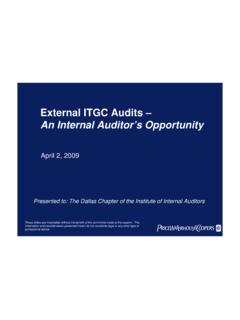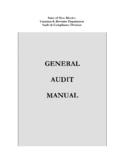Transcription of POLICY DEVELOPMENT GUIDE - Office of the …
1 Office of the Auditor general MANITOBA A GUIDE To POLICY DEVELOPMENT A GUIDE TO POLICY DEVELOPMENT January 2003 - Manitoba - Office of the Auditor general . TABLE OF CONTENTS INTRODUCTION .. 1 DEFINITIONS .. 2 PART A: LEADING AND MANAGING POLICY 3 1. Leadership Direction and Support .. 3 2. Human Resources .. 8 3. Infrastructure Support .. 9 PART B: POLICY PROCESS ATTRIBUTES ..11 4. Issue Identification ..13 5. Issue Analysis ..15 6. Generating Solutions ..18 7. Consultation ..24 8. Performance PART C: POLICY PRODUCT ATTRIBUTES ..30 9. 10. Evidence ..35 11. Options ..38 12. Logic ..41 13. Consultation ..43 14. Presentation ..44 SOURCES OF INFORMATION ..46 RELEVANT COURSES AVAILABLE THROUGH ORGANIZATION AND STAFF DEVELOPMENT (OSD) MANITOBA CIVIL SERVICE COMMISSION.
2 48 ACKNOWLEDGEMENTS ..51 A GUIDE TO POLICY DEVELOPMENT January 2003 - Manitoba - Office of the Auditor general - .1 INTRODUCTION This GUIDE is in direct response to the widespread interest generated by the November 2001 report of the Office of the Auditor general of Manitoba entitled, A Review of the POLICY DEVELOPMENT Capacity Within Government Departments. We were contacted by various Manitoba Government POLICY staff seeking information on where they could find how to guides on POLICY DEVELOPMENT . Through our work in this area, we determined that there is a gap in terms of available guides to assist POLICY practitioners. The fundamental purpose of this GUIDE is to promote excellence in POLICY DEVELOPMENT . The GUIDE is aimed at: those in a leadership or management position whose responsibilities include the POLICY function (see Part A); and POLICY analysts (see Parts B and C).
3 Guidance is provided for each of the attributes in the model of effective POLICY DEVELOPMENT contained in the above-mentioned November 2001 report. We have tried to provide some practical suggestions on how to handle the more challenging aspects of POLICY DEVELOPMENT . In this regard, we have included the perspective of some current and former cabinet ministers with respect to the role of POLICY options in the POLICY DEVELOPMENT process (Section ). We encourage you to review that section of the GUIDE as it sheds light on the expectations of cabinet ministers. By no means is this GUIDE the final word on POLICY DEVELOPMENT . Each of you has your own practical experience of what works well and what does not. Moreover, practical experience is not static. With each piece of POLICY work is an opportunity to refine one s approach based on previous experience.
4 We welcome your comments and observations on the GUIDE . A GUIDE TO POLICY DEVELOPMENT January 2003 - Manitoba - Office of the Auditor general - .2 DEFINITIONS POLICY In this GUIDE , POLICY refers to those plans, positions and guidelines of government which influence decisions by government ( , policies in support of sustainable economic DEVELOPMENT or policies to enhance access to government services by persons with disabilities). There are various types and forms of POLICY . Among the range of POLICY types are: broad POLICY which enunciates government-wide direction; more specific POLICY which may be developed for a particular sector (the economy) or issue-area (child welfare); operational POLICY which may GUIDE decisions on programs, and project selection. With respect to the forms that government POLICY can take, it is reflected most typically in legislation, regulations, and programs.
5 These are often referred to as POLICY instruments. POLICY DEVELOPMENT The activity of developing POLICY generally involves research, analysis, consultation and synthesis of information to produce recommendations. It should also involve an evaluation of options against a set of criteria used to assess each option. Leadership And Management Positions Throughout this GUIDE , a leadership/management position includes any of the following who may have POLICY responsibilities: deputy ministers, assistant deputy ministers, directors, executive directors, coordinators or team leaders. POLICY Analyst Within the context of the Manitoba government, planning and program analysts are often engaged in POLICY work among other things. Likewise, much of what a legislative analyst does is essentially POLICY work.
6 Also, program delivery staff may be involved in POLICY DEVELOPMENT . Thus the term POLICY analyst is used in this GUIDE to refer to all such staff and other positions whose duties include the activities associated with POLICY DEVELOPMENT described above. Consultation In this GUIDE , consultation refers to seeking input ( , advice, reactions, clarifications, etc.) during the POLICY DEVELOPMENT process from individuals within government and those external to government. A GUIDE TO POLICY DEVELOPMENT January 2003 - Manitoba - Office of the Auditor general - .3 PART A LEADING AND MANAGING POLICY DEVELOPMENT An effective organizational environment is one that demonstrates three key attributes: Leadership Direction And Support, Human Resource Capacity, Infrastructure Support.
7 Each of these attributes is interrelated and together they form the foundation of an organization s capacity to perform. They form part of the model of effective POLICY DEVELOPMENT that is explained in the November 2001 report of the Office of the Auditor general of Manitoba entitled, A Review of the POLICY DEVELOPMENT Capacity Within Government Departments (available at ). For more information on each of these attributes, refer to the November 2001 Report. Part A deals with each of the above listed attributes from the perspective of what POLICY leaders and managers can do to facilitate organizational effectiveness in POLICY DEVELOPMENT . The Following Topics Are Covered In Part A: Section 1: Leadership Direction and Support Section 2: Human Resources Section 3: Infrastructure Support Driving and Sustaining POLICY DEVELOPMENT Investing In People Having The Right Tools To Do The Job What Does Process Management Entail?
8 Tip On Strengthening Human Resources Capabilities Dealing With Infrastructure Availability And Cost Issues What Does Providing Staff With The Necessary Resources Entail? Risks Associated With Human Resources What Does Product Management Entail? Questions To Ask Yourselves In Relation To Human Resources Risks Associated With Not Providing Leadership Direction And Support Questions To Ask Yourselves In Relation To Leadership Direction And Support A GUIDE TO POLICY DEVELOPMENT January 2003 - Manitoba - Office of the Auditor general - 4. SECTION 1: LEADERSHIP DIRECTION AND SUPPORT Driving And Sustaining POLICY DEVELOPMENT An important aspect of leadership direction and support is championing excellence in POLICY DEVELOPMENT . One of the best ways to communicate this is through: process management; providing staff with the necessary resources; and product management (the POLICY paper or presentation that is generated).
9 What Does Process Management Entail? Determining If Issues Are Cross-Cutting Increasingly, issues of the day and solutions to them are multi-faceted and multi-layered often involving more than one department, level of government or non-governmental agency. Alternatively put, POLICY issues are more often than not cross-cutting or have horizontal implications. Thus one of the critical strategies to successful POLICY DEVELOPMENT is to identify who needs to be involved in the process. POLICY leaders/managers need to identify whether a particular POLICY issue is cross-cutting and if so, they need to ensure that the right people are included in the POLICY DEVELOPMENT process. Assigning Suitable Resources Another critical aspect of leading/managing the POLICY process is assigning the right resources to address the POLICY issue at hand.
10 POLICY leaders/managers should be careful to resist the temptation of assigning whatever resources are available at the time to work on a particular issue. Within the context of stretched resources, this may mean temporarily re-assigning staff or reprioritizing work in order to achieve the best results within the necessary time frames. To effectively assign resources, leaders/managers need to: be clear on the inventory of expertise and knowledge of their staff; identify the particular mix of skills required for a given POLICY project; and assemble the resources that most closely fit the skill set identified as required under the given circumstances. Demanding Excellence Another essential ingredient to effective leadership and management of the process is the expectations that leaders/managers place on their staff.





